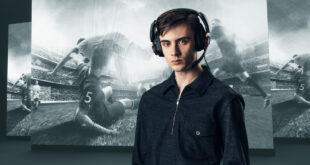Though the soul of eSports growth in the past few decades has been a grassroots community, the heart has certainly been increasing sponsorship.
According to this year’s Newzoo report, 30 percent of revenue in the industry comes from sponsors – almost identical to the 31 percent seen in traditional sports.
With such a growth market still in its infancy, it is all to familiar to see brands attempt and fail to promote their products to an audience they don’t quite understand.
ESL’s Vice-President of Partnerships and Publisher Relations has spent much of the past decade ensuring those looking to enter the fabled ‘lucrative world of eSports’ do so in the right way – and for the right reasons.
"I sit on two sides of sponsorship," Charles tells eSports Pro. "One is the classical there is a brand and the brand wants to be visible in eSports and the other side is a game, or a publisher or developer, that wants their product to be visible in eSports.
Publisher and developer involvement is a huge boon for eSports – one that doesn’t exist in the traditional sports model the industry is based on – offering 24 percent of all revenue in the sector.
"On both of those sides I work with the teams responsible for the making of that decision and I try to find a way to authentically position them within the eSports ecosystem and then work on actually executing that together with my team."
Authenticity is a huge question when it comes to marketing to eSports audiences, of which there are estimated to be 89m enthusiasts worldwide (compared to 94m ice hockey fans).
With a demographic between 14-36 years old, and predominately male (Charles estimates between 85-90% though admits the industry is slowly opening to accomodate more female audiences) eSports viewership sits in the sweet spot for marketers.
But due to their internet-savvy nature, and the grassroots origins of eSports making many wary of the encroachment of commercialisation on their hobby, the audience can be cagey and difficult to promote to in traditional ways.
"I would say that eSports in itself presents a very good way to approach that because, by its very essence, eSports is something that if you’re involved in it then you’re doing a good thing already," Charles said. "I wouldn’t say it’s a clubhouse but it is a thing that if you understand and care about it then you are already halfway there to being involved in it."
This approach is easy enough for what Charles describes as the endemic brands within eSports – those who were tightly associated and involved in its initial inception – hardware providers like Razer, SteelSeries and Intel. Intel itself has earned a lot of goodwill in the community for having grown the scene with their Intel Extrem Masters competitions. But it becomes a different story for non-endemic brands looking to appeal to the same audience.
Charles believes the transition sponsorship is going through in eSports is very similar to 60s and 70s motorsport, where the Perelli, Dunlop and Castrol brands are being joined by Tag Heuer or Seiko or other time-piece makers who see an audience who could also be interested in what they provide. But there is a danger to that.
"It can come across as ‘Why is this tacked on?’ so that’s where this value-added proposition comes in," Charles explained. "When you say you want to do something that gives you a look into the world you are attracted to, if you can add on and develop that world with your brand you’ve got a win-win situation. If the brand is the key to unlocking the content they want to consume then you just need to find that relationship, which is what we do day in day out."
At ESL One Frankfurt, the endemic sponsors include NVidia, who have chosen to be represented at the tournament by providing the GPUs and monitors for the event, a simple enough link to make. But when the sponsor is more mainsteam, like Pizza Hut or online financial service PaySafe, work has to be put in to make sure the proposition isn’t detracting from the experience.
"If you’re already open to watching a few hours of eSports online, then you’re probably also buying online from some of the big retailers for merch, so there’s already a connection," Charles said. "We just have to make that step to making that first user experience with PaySafe as easy as possible.
"So it could be something as easy as saying ‘Purchase the t-shirt from this event at a discounted rate when using PaySafe.’ That way, their branding is there, every person watching potentially would like to have the t-shirt – we see great numbers on merchandise – and we’re offering something where they’re ultimately getting more for less."
As eSports can be a less physically social form of entertainment, though involves heavy online social interaction via broadcaster chat rooms, any jarring messages can spiral out of control without the distractions of local conversations.
At the recent The Summit 3 Dota 2 tournament, lengthy match breaks were filled in by an experimental, informal infommercial style of marketing for betting site Vulcun by the tournament hosts and casters. Though the brand is clearly endemic and related, the length of segments caused viewers to be so vocally against the practice that organisers Beyond The Summit produced a (tongue-in-cheek) rebuttal to claims they were ‘only in it for the money.’
"It’s the same phenomenon that you see at classic sporting events like the Champion’s League or the Super Bowl," Charles said. "The commitment is that they’re going to be there for the next 90 minutes complete with all the intros and outros. It’s an hour and a half journey that’s very similar to watching a feature length movie, so that person is very much a captive audience. So if you can make your messaging for a captive audience fit and be something that adds value you have a very high interaction rate with that person."
The captive audience is very appealing to sponsors, but if brands want to earn the same goodwill that Intel has then they need to approach the situation in an intelligent way, treating the opportunity as a conversation.
"What you see now is the real kind of tipping point, with numbers becoming the largest way to reach millennials and difficult-to-approach ‘digital natives’," Charles said. "eSports is a vehicle that a lot of people are switching on to as a way we can have an authentic conversation with those guys and support whatever we are putting in front of them."

 MCV/DEVELOP News, events, research and jobs from the games industry
MCV/DEVELOP News, events, research and jobs from the games industry



